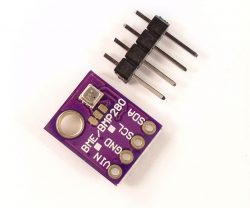BME680: Environment & Air Quality Sensor
Saturday 22 July 2017 |
Category: Open Hardware
Bosch’s new all-in-one environmental sensor chip has just hit the shelves, measuring air pressure, temperature, humidity and air quality all in a tiny package.

For over a year now, we have been patiently awaiting the BME680. Finally, the wait is over with Mouser announcing distribution of the chip throughout Europe this week. At £7.63 for an individual unit, this is a huge leap forward for low-cost environmental sensing.
Intro
Bosch are at the forefront in developing advanced integrated environmental chips, with designing coming a long way in a short time (check out the diagram below).

To illustrate this point, the BMP280 (pressure & temp) was released in 2012, BME280 (+ humidity) 2013, with the new BME680 (+ volatile organic gas) in 2015. With it now made easily available to the masses, we have a cause to celebrate as it is surely just a matter of time (maybe even just a few short weeks) before we can expect breakout boards for the unit (see below. Note: Bosch already have their own breakout costing £30 from Mouser). Having used Bosch’s other environmental IC sensors throughout many student projects, we know these perform brilliantly and can be scooped up for extremely cheap. A quick check on eBay, shows the BME280 version is just £1.30 including postage!

Example of potential breakout board for BME680
What is an Integrated Circuit?
Everyone has seen those insect-like chips on circuit boards. For those unaware, these chips – known as Integrated Circuits (ICs) – can be thought of as a chip which can perform Electronic wizardry. Put simply, an IC houses an entire circuit within it, hence the name. Transistors, capacitors, sensing components and connecting wires are all housed within (see this video zooming into an IC). Whilst we *might* be able to make a circuit which performs the same task, the simplicity of buying a tiny pre-made chip has allowed electronics to become what it has today. Taking the BME680 as an example, as well as performing measurements of pressure, temperature, humidity and “air quality”, it also calibrates the readings and digitally communicates these to other devices (e.g. Arduino, Raspberry Pi). Neat huh?
Gas sensor / “Indoor Air Quality”?
The latest addition to Bosch’s all-in-one sensor is a “gas” or “air quality” sensor. In reality, this is a Volatile Organic Compounds (VOC) sensor. VOCs are organic (carbon) compounds with a high propensity to become gaseous/vapour at low temperatures. Definitions however vary considerably. Whilst not all VOCs are seriously detrimental to health (ethanol hand sanitisers being a good example), many can have carcinogenic effects, causing dizziness, headaches, nausea, allergic reactions, memory loss, triggering allergic reactions, or even cancer, birth defects and reproductive problems. Though most strong chemical smells can be attributed to VOCs, others are odourless making them hard to detect. VOCs are off-gassed by liquids and even solids, various sources including from hydrocarbons, building materials, pharmaceuticals and cosmetics, cleaning fluids, glues, alcohols, paints and printing.
The BME680 measures VOCs via a resistance sensor (i.e. resistance changing with concentration of VOCs). Whilst the raw reading can be queried from the device, the sensor can also output a calibrated measure called Indoor Air Quality (IAQ). Calibration is however not a standardised unit; rather, the measure is calibrated according to the general conditions of where the sensor has been running. The sensor will set an IAQ value of 25 for “good” air quality for the area and 250 for a typical polluted air event, typically calibrating these over the last ~4 day sensing period. Whilst this clearly poses some problems for standardisation between devices, the raw resistance reading is attainable allowing different devices to be cross-calibrated. Having asked Bosch for clarification, I can also confirm that the resistance reading should not severely deteriorate over the course of the sensor’s life. Calibrating against scientific units however would require the use of specialist equipment.
The sensor has also been tested with breath VOC (b-VOC). This is of interest as exhaled breathe is correlated with human health. Note: despite CO2 being a VOC, the sensor does not detect it.
Whilst VOC is an important determinant of air quality, it is far from a comprehensive measure (other important components being nitrogen dioxide, ozone and particulates). However, as it encompasses such a large range of harmful chemicals, we welcome the incorporation of it in such a small package for such little cost. Furthermore, its incorporation of the standard environmental metrics, good for any low-cost terrestrial sensor, makes it perfect for combining with particulate sensors such as the Sharp GP2Y1010AU0f.
BME680 useful info
- 1.71-3.6v supply voltage
- I2C or SPI communication (available on all devices)
- Extremely low power consumption (3.6 µA for temp, pressure, humidity once a second, ).
In addition to environmental sensing applications, it’s miniscule size means it could well become embedded in everyday devices such as smart watches, mobile phones, tablets or computers. From their advertising, it would appear Bosch are keen to market it towards being embedded in mobiles. This would likely mean a trade-off with waterproofness (yes it’s a word).
Relevant links
Bosch Links:
Mouser Links: